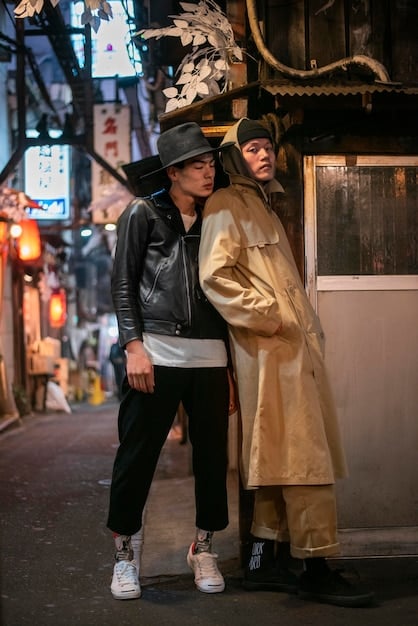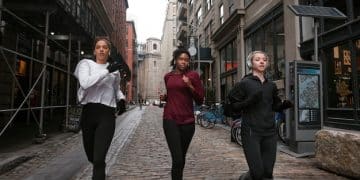The Evolution of Streetwear: Tracing Its Rise from Subculture to Mainstream Fashion

The evolution of streetwear traces its origins from marginalized subcultures like skateboarding and hip-hop to its current status as a dominant force in mainstream fashion, influencing high-end designers and everyday consumers alike.
The world of fashion is ever-evolving, with trends constantly appearing and disappearing. However, some styles manage to transcend fleeting fads and establish themselves as enduring cultural movements. The evolution of streetwear: From subculture to mainstream fashion, is one such phenomenon, transforming from a niche style embraced by skaters and hip-hop artists to a global force influencing everything from high fashion runways to everyday wardrobes.
From Underground Roots: The Birth of Streetwear
Streetwear’s origins can be traced back to the late 1970s and early 1980s, emerging from the fringes of youth culture. It wasn’t conceived in Parisian ateliers or Milanese design houses. Instead, it was born on the streets, fueled by the creativity and independent spirit of subcultures like skateboarding, hip-hop, and punk rock.
Skateboarding Culture’s Influence
Skateboarding culture played a pivotal role in shaping the early aesthetics of streetwear. Skaters needed durable, comfortable clothing that could withstand the wear and tear of their activities. This led to the adoption of practical garments like t-shirts, hoodies, and sneakers, often customized with logos and graphics that reflected their individual style and affiliation with specific skate brands.
Hip-Hop’s Impact on Fashion
Hip-hop culture also left an indelible mark on streetwear. As hip-hop music gained popularity, artists began using fashion as a means of self-expression and cultural identity. They embraced bold, oversized silhouettes, athletic-inspired pieces, and luxury brands, creating a distinctive look that resonated with their fans and helped to define the era.

- DIY Customization: Early streetwear was all about customization, with individuals adding their own personal touches to garments through screen printing, patches, and other embellishments.
- Emphasis on Comfort and Functionality: Comfort and functionality were key considerations in early streetwear designs, reflecting the practical needs of skaters and hip-hop artists.
- Brand Loyalty: Streetwear enthusiasts developed a strong sense of brand loyalty, supporting independent labels and emerging designers who shared their values and aesthetic sensibilities.
The fusion of these subcultural influences created a unique and compelling style that challenged traditional fashion norms. Streetwear represented a rejection of elitism and conformity, celebrating individuality, creativity, and self-expression.
Key Figures Who Shaped Streetwear
Several individuals played a crucial role in the rise of streetwear, acting as catalysts for its growth and evolution. These visionaries, designers, and entrepreneurs helped to shape the aesthetic and cultural significance of streetwear, transforming it from a niche subculture into a global phenomenon.
Shawn Stussy: The Godfather of Streetwear
Shawn Stussy is widely regarded as the “Godfather of Streetwear.” In the early 1980s, he began selling t-shirts and surfboards adorned with his signature graffiti-inspired logo out of his car. Stussy’s designs resonated with the skate and surf communities, and his brand quickly gained a cult following. His approach was based on the idea of creating a tribe through exclusive limited quantities.
Hiroshi Fujiwara: The Harajuku Pioneer
Hiroshi Fujiwara, often called the “Godfather of Streetwear” in Japan, was instrumental in introducing streetwear to the Japanese market. He imported American streetwear brands and culture to Tokyo’s Harajuku district, which soon became a hub for streetwear enthusiasts. Fujiwara also launched his own influential brands, such as GOODENOUGH and fragment design, further solidifying his status as a pioneer.

- NIGO (A Bathing Ape): NIGO founded A Bathing Ape (BAPE) in 1993, which became synonymous with Japanese streetwear. BAPE’s signature camouflage prints, graphic t-shirts, and collaborations with other brands helped to propel streetwear into the mainstream.
- James Jebbia (Supreme): James Jebbia founded Supreme in 1994, a skate shop and clothing brand that quickly became a cultural phenomenon. Supreme’s limited-edition drops, collaborations with artists and designers, and association with skate culture made it one of the most coveted streetwear brands in the world.
- Virgil Abloh (Off-White): Virgil Abloh, the late artistic director of Louis Vuitton menswear and founder of Off-White, was a transformative figure in streetwear. He bridged the gap between streetwear and high fashion, infusing luxury brands with streetwear aesthetics and collaborating with established sportswear companies.
These individuals were not just designers or entrepreneurs; they were cultural innovators who understood the power of community, exclusivity, and self-expression. They created brands that resonated with a generation seeking to define their own style and identity, laying the foundation for the global streetwear industry we know today.
The Internet’s Role in Streetwear’s Popularization
The rise of the internet and social media has profoundly impacted the growth and accessibility of streetwear. The digital landscape has enabled streetwear brands to connect with consumers globally, bypassing traditional retail channels and creating new opportunities for community building and self-expression.
Online Retail and E-Commerce
Online retail platforms have made it easier than ever for streetwear brands to reach a global audience. E-commerce allows brands to showcase their products, manage inventory, and fulfill orders directly to consumers, without the need for brick-and-mortar stores. This has leveled the playing field, allowing smaller, independent brands to compete with established players in the fashion industry.
Social Media’s Amplifying Effect
Social media platforms like Instagram, Twitter, and TikTok have played a crucial role in amplifying streetwear culture. These platforms provide a space for enthusiasts to share their style, discover new brands, and connect with like-minded individuals. Influencers and celebrities often showcase streetwear styles, further contributing to their popularity and desirability.
The role of the Internet in streetwear’s popularization is undeniable. It democratized access, fostered community, and amplified trends, accelerating the transformation of streetwear from a subculture to a dominant force in global fashion.
High Fashion’s Embrace of Streetwear
In recent years, high fashion has increasingly embraced streetwear, with luxury brands collaborating with streetwear labels and incorporating streetwear elements into their collections. This convergence of high and low fashion has blurred the lines between the two worlds and has further legitimized streetwear’s place in the mainstream.
Luxury Collaborations
Luxury brands like Louis Vuitton, Dior, and Gucci have collaborated with streetwear labels like Supreme, Stussy, and BAPE, creating highly sought-after collections that blend high-end craftsmanship with streetwear aesthetics. These collaborations not only generate buzz and excitement but also introduce luxury brands to a younger, more diverse audience.
Inspiration from Streetwear
High fashion designers are increasingly drawing inspiration from streetwear, incorporating elements like oversized silhouettes, athletic-inspired pieces, and bold graphics into their collections. This trend reflects a broader shift in the fashion industry towards more casual, comfortable, and accessible styles.
- Breaking Down Barriers: The embrace of streetwear by high fashion has helped to break down traditional barriers and hierarchies within the fashion industry.
- New Consumer Base: Streetwear collaborations and influences have helped luxury brands tap into a new consumer base, attracting younger and more diverse shoppers.
- Redefining Luxury: The integration of streetwear elements has redefined luxury, making it more accessible, relatable, and relevant to contemporary culture.
The embrace of streetwear by high fashion signifies a significant shift in the fashion landscape. It reflects the growing influence of youth culture, the democratization of style, and the blurring of boundaries between high and low fashion.
Streetwear’s Cultural Significance
Streetwear’s significance extends beyond mere clothing. It represents a cultural movement, a form of self-expression, and a reflection of the values and aspirations of a generation. By incorporating elements from music, art, and sport, streetwear has become a powerful vehicle for cultural commentary and social change.
Voice of the Youth
Streetwear provides a voice for young people, allowing them to express their individuality, values, and cultural affiliations through their clothing. Streetwear brands often support social causes and engage in activism, using their platforms to raise awareness and promote change.
Mirror of Social Trends
Streetwear often reflects broader social trends, such as the rise of social media, the growing importance of sustainability, and the increasing awareness of social justice issues. Streetwear brands are adapting to these trends by incorporating eco-friendly materials, promoting ethical manufacturing practices, and supporting social causes.
Streetwear is more than just a fashion trend; it is a reflection of the times. Its cultural significance lies in its ability to empower individuals, amplify voices, and reflect the ever-changing landscape of society.
The Future of Streetwear: Sustainability, Inclusivity, and Innovation
As streetwear continues to evolve, several key trends are shaping its future. Sustainability, inclusivity, and innovation are becoming increasingly important considerations for brands and consumers alike.
Sustainable Streetwear
The fashion industry as a whole is facing increasing pressure to become more sustainable, and streetwear is no exception. Brands are exploring eco-friendly materials, such as organic cotton, recycled polyester, and innovative new fabrics, as well as adopting ethical manufacturing practices and reducing waste.
Inclusivity and Diversity
Streetwear is becoming more inclusive and diverse, with brands featuring models of all races, genders, and sizes in their campaigns. Promoting diversity is not only the right thing to do but also makes good business sense, as it reflects the diverse customer base that streetwear now serves.
- Technological Innovations: New technologies, such as 3D printing and virtual reality, are opening up exciting opportunities for streetwear brands to innovate and create unique, personalized products.
- Personalization is Key: Consumers are increasingly seeking out personalized experiences, and streetwear brands are responding by offering customization options, exclusive drops, and personalized marketing campaigns.
The future of streetwear is bright, driven by innovation, inclusivity, and a growing commitment to sustainability. As streetwear continues to evolve, it will undoubtedly remain a powerful force in fashion and culture.
| Key Point | Brief Description |
|---|---|
| 🛹 Subculture Origins | Emerged from skateboarding, hip-hop, and punk cultures in the late 70s and early 80s. |
| 👨🎨 Key Influencers | Figures like Shawn Stussy, Hiroshi Fujiwara, and Virgil Abloh shaped the industry. |
| 🌐 Internet Impact | Online retail and social media amplified streetwear’s global reach and popularity. |
| ♻️ Future Trends | Sustainability, inclusivity, and technological innovation are driving streetwear’s evolution. |
Frequently Asked Questions
▼
Streetwear is heavily influenced by subcultures such as skateboarding, hip-hop, and punk rock. These influences are reflected in its emphasis on comfort, functionality, and self-expression through clothing.
▼
Key figures include Shawn Stussy, Hiroshi Fujiwara, NIGO, James Jebbia, and Virgil Abloh. These individuals founded influential brands and helped to shape the aesthetic and cultural significance of streetwear.
▼
The internet has enabled streetwear brands to reach a global audience and connect with consumers directly. Social media has also played a crucial role in amplifying streetwear culture and promoting new trends.
▼
High fashion has increasingly embraced streetwear, with luxury brands collaborating with streetwear labels and incorporating streetwear elements into their collections. This convergence has blurred the lines between the two worlds.
▼
Sustainability, inclusivity, and innovation are becoming increasingly important considerations for streetwear brands. These trends are shaping the future of the industry and reflecting broader social values.
Conclusion
From its humble beginnings in the underground scenes of skateboarding and hip-hop to its current status as a global phenomenon, streetwear has undergone a remarkable transformation. With its emphasis on self-expression, community, and cultural commentary, streetwear has become more than just clothing; it is a reflection of the times. As it continues to evolve, driven by innovation, sustainability, and inclusivity, streetwear is poised to remain a powerful force in fashion and culture for years to come.





